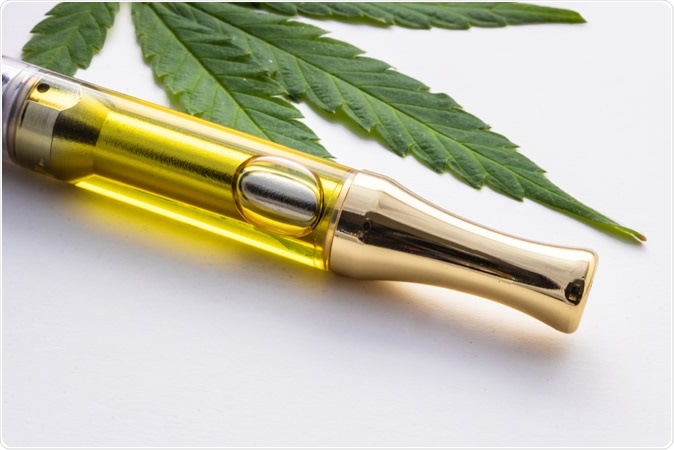Marijuana vaping usage up among American teenagers
A new study published in the journal JAMA Pediatrics in April 2020 shows that more and more American teenagers were turning to vaping and ingesting marijuana in various forms over the period 2015 to 2018. This is a disturbing trend given the increasing evidence that chronic marijuana use at this age does cause abnormal development as well as causing social consequences.
It is well known that adolescents find it easier to obtain marijuana in forms that aren’t suitable for smoking. However, there haven’t been many studies comparing the use of this weed in different forms. It is evident that the use of e-cigarettes, or vaping, has gone up markedly among adolescents. Marijuana-containing foods are also being sold commercially.
In the absence of solid research, there isn’t much knowledge about which of these products are being used by teenagers across America and how much. While data from regional surveys suggest that vaping is more widespread among boys, there is no consensus on the trends concerning the use of marijuana-containing edibles in either sex, in different ethnicities, and for people at different socioeconomic levels.
What did the study do?
The researchers used data from the Monitoring the Future survey, conducted over 2015 to 2018 in about 9,000 students in the 12th grade. All students (or their parents, in the case of minors) gave active or passive consent for the study.
The study found that about 33% of these students had used marijuana over the last 12 months. Over 80% of these provided complete information for the purposes of the study, including their use of marijuana by smoking, vaping and edibles. The investigators also applied characteristics like gender, race, parental education, and the school location for the degree of urbanization.
The researchers classified frequency of use over the last 30 days into two categories, for simplicity, into daily or regular use, where the drug was used 20 or more times in this period, and less frequent use.
The findings
Of the 2,428 students included in the study in 2018, about 27% (746 students) said they had used marijuana over the past year. About 89% of this number said they had smoked the drug.
When compared to usage trends over the past three years, from 2015 to 2018, marijuana smoking went down from about 95% in 2015 to 89% in 2018. The percentage of students who ate the drug in any form was 40%, up from 32% in 2015, while 34% said they vaped it, up from 26% in 2015. This comes to 12% and 13% of the total number of students (2,428).
In 2018, over 30% of users reported dabbing the drug, and 4% said they had drunk it.
Most of these students also smoked the drug. In fact, only 12% of those who vape and 8% of edible consumers said they had not smoked it over the past year. Almost 18% of smokers, 29% of vapers, and 27% of edible consumers said they used the drug daily.
As expected from earlier research, more boys than girls used the drug in vaping or edible form. The odds for edible consumption among boys were a third more than among girls, while the odds of vaping were twice as high for boys than girls in this age group. However, more girls smoked marijuana than boys.
Do marijuana use trends reflect ethnic differences?
White teenagers were more likely to smoke, vape, or eat marijuana than almost any other race (Hispanic, blacks, and non-Asian others). However, Asian teenagers were more likely to eat and to vape marijuana, with the odds being higher by 38% and 22%, respectively.
The odds of marijuana consumption in all forms was lower among blacks than among whites. For Hispanics, only the odds of smoking the drug were lower, with the use of the other forms being comparable. Among Asians, too, the odds of marijuana smoking were lower despite the higher odds of using the other forms.
Do socioeconomic factors affect marijuana use?
Higher parental education was linked to a lower risk of using the drug in any form except vaping. This could indicate that young people with a higher socioeconomic status were at lower risk for the use of this drug in most cases but were vulnerable to the pull of e-cigarettes.
Urban and suburban teenagers were least likely to smoke, with almost 50% and 30% lower odds among these groups, respectively. However, urban youth had twice the odds, or more, of eating or vaping the drug. Suburban youth, however, was at 60% higher odds for eating the drug-containing edibles.
What does the study show about teenage marijuana use?
Overall, the decrease in marijuana smoking and the increase in the use of other non-combustible forms of the drug among adolescents is observable in this study. This is comparable to the figures for vaping of other substances. The changing trends should show the great need to monitor the behavior and attitudes among young people. Vaping and edible drug consumption were more associated with daily use compared to smoking. Well over one in four of the former group used the drug daily, suggesting that healthcare providers should screen for heavy drug use through these routes among teenage patients.
The authors mention the apparent limitations of the studies. For one, the data comes from high school seniors, and therefore the usage trends among absent or dropout students are automatically excluded. Despite this, it throws light on the increasing tendency to use marijuana, and the increasing legalization of marijuana as a recreational drug should prompt increasing intervention to monitor its use and the associated side effects in this vulnerable population.
Patrick, M. E., et al. (2020). Trends in Marijuana Vaping and Edible Consumption From 2015 to 2018 Among Adolescents in the US. JAMA Pediatrics. Published online April 6, 2020. doi:10.1001/jamapediatrics.2020.0175.


